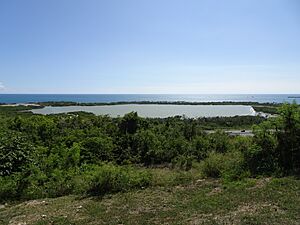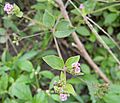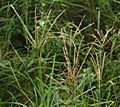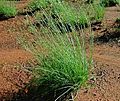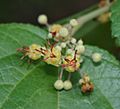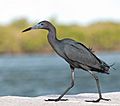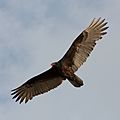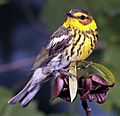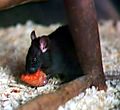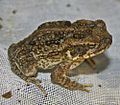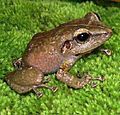Reserva Natural Punta Cucharas facts for kids
Quick facts for kids Reserva Natural Punta Cucharas |
|
|---|---|
| Punta Cucharas Nature Reserve | |

Sign at the entrance to Reserva Natural Punta Cucharas
|
|
| Lua error in Module:Location_map at line 420: attempt to index field 'wikibase' (a nil value). | |
| Location | Barrio Canas, Ponce, Puerto Rico |
| Nearest city | Ponce |
| Area | Total (Land): 698 cuerdas (678 acres) Total (Marine): 3,516 cuerdas (3,415 acres) Las Salinas Lagoon only: 347,898 m2 (86 acres) |
| Designation | 2008 |
| Governing body | Puerto Rico Department of Natural and Environmental Resources |
| Fauna and Flora at Reserva Natural Punta Cucharas |
|
|---|---|
| Location | Ponce, Ponce, Puerto Rico |
| Established | 2008 |
| Named for | Coastal geographical formation |
| Governing body | Puerto Rico Department of Natural and Environmental Resources |
| Website | Puerto Rico Department of Natural and Environmental Resources |
The Reserva Natural Punta Cucharas (Punta Cucharas Nature Reserve) is a special nature reserve in Ponce, Puerto Rico. It includes both land and ocean areas. The land part is about 698 acres, and the ocean part is about 3,516 acres. This makes the total area around 4,214 acres.
The reserve is home to different natural environments. These include mangrove forests, sandy dunes along the coast, and a salty lagoon called Laguna Las Salinas. This lagoon covers about 347,898 square meters. The Puerto Rico Department of Natural and Environmental Resources helps protect and manage this amazing place.
You can enjoy many activities here, like scuba diving, boating, fishing, and hiking. It's also great for sunbathing, photography, and bird watching. You can even go canoeing! However, some activities are not allowed. These include camping, crabbing, horseback riding, and hunting. Please also leave your pets, ATVs, and campfires at home.
Contents
History of Punta Cucharas Reserve
The journey to protect Punta Cucharas began in 2001. The Puerto Rico Ornithology Society suggested it as an important area for birds. From 2003 to 2004, the United States Geological Survey studied the Laguna Las Salinas. The Ponce Municipal Government supported this study.
In 2004, the Natural Patrimony Division of the DRNA reported on the area's natural value. Later, in 2008, a local group called Amigos de La Laguna (Friends of the Lagoon) spoke out. They warned about how a gas pipeline project could harm the lagoon.
Because of these efforts, the Legislature of Puerto Rico passed Law 227 in August 2008. This law officially made Punta Cucharas a nature reserve. On August 9, 2008, it became a protected area by law.
Where is Punta Cucharas and How Big is It?
This special area is located along the coast of Barrio Canas. To the west, you'll find a tourist area with a hotel. Modern homes are to the north. To the south is the beautiful Caribbean Sea.
The reserve includes all the land southeast of Road PR-2 in Barrio Canas. It also covers the marine areas around Isla de Ratones and Isla Cardona. These two islands are south of Ponce and are part of the reserve.
The main feature is Laguna Salinas, a salty lagoon. It measures about 347,898 square meters. The reserve also has mangrove forests and other coastal forests. You'll find different types of wetlands and marshy areas too. Large areas of sand dunes are covered with herbaceous vegetation. The total land area of the reserve is 698 cuerdas. The Salinas Lagoon has a mangrove forest that covers about 37 acres.
Why Punta Cucharas is Important for Nature
The city of Ponce knew how important the Punta Cucharas area was for nature. They included a special plan for it in their city's development rules. This plan aimed to protect natural resources like Laguna Salinas and its wetlands. It also allowed for some development, but only if nature was protected.
The city's plan wanted to create a special protection zone. This zone would keep the wetlands and the Laguna Salinas safe. The goal was to make Punta Cucharas a "high interest" place for ecotourism. This means it's a great spot for people to visit and enjoy nature while helping to protect it.
Shoreline and Habitats at Punta Cucharas
The shoreline of the reserve has several types of habitats. You can see mangroves that are open to the sea. There are also beaches with a mix of sand and gravel. Other beaches have very fine sand. The wildlife here includes many wading birds and shore birds.
Plants and Animals of Punta Cucharas
The reserve is home to many different living things. It has 148 types of plants and 56 kinds of birds. You can also find five types of mammals, nine reptile species, five amphibians, and six fish species.
Amazing Plants of Punta Cucharas
Some plants in the reserve are very rare and need protection. These include the Cordia rupicola and Leptocereus quadricostatus (sebucan), which are critically endangered. The Guaiacum officinale (guaiac tree) is endangered, and the Maytenus ponceana is vulnerable. Here are some of the 147 plant species found here:
| No. | Species | Family | Common Name (Spanish) | Common Name (English) |
|---|---|---|---|---|
| 1 | Aloe vera | Liliaceae | sábila | aloe vera |
| 2 | Acacia farnesiana | Fabaceae | aroma | sweet acacia |
| 3 | Achyranthes aspera | Amaranthaceae | rabo de gato | devil's horsewhip |
| 4 | Annona glabra | Annonaceae | cayur | corkwood |
| 5 | Antigonon leptopus | Polygonaceae | bellísima | coral vine |
| 6 | Arundo donax | Poaceae | caña de castilla | Spanish cane |
| 7 | Avicennia germinans | Verbenaceae | mangle negro | black mangrove |
| 8 | Batis maritima | Bataceae | yerba de sal | saltwort |
| 9 | Boerhavia diffusa | Nyctaginaceae | mata pavo | tarvine |
| 10 | Bucida buceras | Combretaceae | ucar | bullet tree |
| 11 | Bursera simaruba | Burseraceae | almácigo | copperwood |
| 12 | Caesalpinia bonduc | Fabaceae | mato de playa | gray nicker |
| 13 | Calotropis procera | Asclepiadaceae | algodón de seda | king's crown |
| 14 | Canella winterana | Canellaceae | barbasco | cinnamon bark |
| 15 | Canavalia rosea | Fabaceae | haba de playa | beach bean |
| 16 | Capparis flexuosa | Capparaceae | palinguan | -- |
| 17 | Capraria biflora | Scrophulariaceae | té del país | goatweed |
| 18 | Cassytha filiformis | Lauraceae | fideillo | lovevine |
| 19 | Cissus trifoliata | Vitaceae | bejuco de caro | sorrelvine |
| 20 | Cleome viscosa | Capparaceae | volantín | spiderflower |
| 21 | Coccoloba diversifolia | Polygonaceae | uvilla | pigeonplum |
| 22 | Coccoloba uvifera | Polygonaceae | uva de playa | seagrape |
| 23 | Colubrina elliptica | Rhamnaceae | mabí | soldierwood |
| 24 | Commelina sp. | Commelinaceae | cohítre | dayflower |
| 25 | Conocarpus erectus | Combretaceae | mangle blanco | buttomwood |
| 26 | Crescentia cujete | Bignoniaceae | higüera | calabash |
| 27 | Cynodon dactylon | Poaceae | yerba Bermuda | Bermuda grass |
| 28 | Dactyloctenium aegyptium | Poaceae | yerba egipcia | Egyptian crowfoot grass |
| 29 | Delonix regia | Fabaceae | flamboyán | poinciana |
| 30 | Desmanthus virgatus | Fabaceae | desmanto | wild tantan |
| 31 | Digitaria decumbens | Poaceae | pangola | digitgrass |
| 32 | Eleusine indica | Eleusine indica | yerba dulce | yard-grass |
| 33 | Eupatorium odoratum | Compositae | cariaquillo santa maría | devil weed |
| 34 | Euphorbia tirucalli | Euphorbiaceae | esqueleto | naked lady |
| 35 | Ficus citrifolia | Moraceae | jagüey | banyantree |
| 36 | Fimbristylis dichotoma | Cyperaceae | junquito | forked fimbry |
| 37 | Forestiera segregata | Oleaceae | privet | ink-bush |
| 38 | Furcraea tuberosa | Agavaceae | maguey | cabuyo |
| 39 | Gossipium barbadense | Malvaceae | algodón | cotton |
| 40 | Guaiacum officinale | Zygophyllaceae | guayacan | guaiacwood |
| 41 | Guazuma ulmifolia | Sterculiaceae | guácima | bay cedar |
| 42 | Gymnanthes lucida | Euphorbiaceae | yaití | crabwood |
| 43 | Heliotropium curassavicum | Boraginaceae | cotorrera de playa | seaside heliotrope |
| 44 | Heteropogon contortus | Poaceae | yerba torcida | black speargrass |
| 45 | Hippomane mancinella | Euphorbiaceae | manzanillo | manchineel tree |
| 46 | Ipomoea pes-caprae | Convolvulaceae | bejuco de playa | beach morning glory |
| 47 | Jatropha gossypiifolia | Euphorbiaceae | túa-túa | bellyache bush |
| 48 | Krugiodendron ferreum | Rhamnaceae | bariaco | leadwood |
| 49 | Laguncularia racemosa | Verbenaceae | mangle blanco | white mangrove |
| 50 | Lantana involucrata | Verbenaceae | cariaquillo | buttonsage |
| 51 | Leucaena leucocephala | Fabaceae | zarzilla | white leadtree |
| 52 | Macfadyena unguis-cati | Bignoniaceae | uña de gato | cat's claw creeper |
| 53 | Melicoccus bijugatus | Sapindaceae | quenepa | genip |
| 54 | Metopium toxiferum | Anacardiaceae | papayo | poisonwood |
| 55 | Opuntia repens | Cactaceae | cactus saltarín* | roving pricklypear |
| 56 | Parkinsonia aculeata | Fabaceae | palo de rayo | Parkinsonia aculeata |
| 57 | Passiflora suberosa | Passifloraceae | flor de pasión | passionflower |
| 58 | Paspalum laxum | Poaceae | matojo de arena | bahiagrass |
| 59 | Pennisetum setaceum | Poaceae | yerba | crimson fountaingrass |
| 60 | Phoenix dactylifera | Araceae | palma de datil | date plam |
| 61 | Pilosocereus royenii | Cactaceae | sebucan | cactus |
| 62 | Pisonia albida | Nyctaginaceae | corcho | birdcatcher tree |
| 63 | Pithecellobium dulce | Fabaceae | guamá americano | -- |
| 64 | Plumbago scandens | Plumbaginaceae | meladillo | doctorbush |
| 65 | Portulaca oleracea | Portulacaceae | verdolaga | pigweed |
| 66 | Prosopis juliflora | Fabaceae | bayahonda | mesquite |
| 67 | Randia aculeata | Rubiaceae | tintillo | white indigoberry |
| 68 | Rhizophora mangle | Rhizophoraceae | mangle rojo | red mangrove |
| 69 | Rivina humilis | Phytolaccaceae | carmín | pigeonberry |
| 70 | Roystonea borinquena | Arecaceae | palma real | Puerto Rican royal palm |
| 71 | Ruppia maritima | Ruppiaceae | yerba de zanja | ditch-grass |
| 72 | Rhynchosia minima | Fabaceae | frijolillo | jumby-bean |
| 73 | Sesbania sericea | Fabaceae | papagayo | riverhemp |
| 74 | Sesuvium portulacastrum | Portulacaceae | verdolaga rosada | shoreline purslane |
| 75 | Solanum elaeagnifolium | Solanaceae | trompillo | silverleaf nightshade |
| 76 | Sporobolus virginicus | Poaceae | matojo de burro | seashore dropseed |
| 77 | Tabebuia heterophylla | Bignoniaceae | roble blanco | white cedar |
| 78 | Talinum paniculatum | Portulacaceae | lengua de vaca | pink baby's-breath |
| 79 | Tamarindus indica | Fabaceae | tamarindo | tamarind |
| 80 | Thespesia populnea | Malvaceae | emajagüilla | Portia tree |
| 81 | Tillandsia recurvata | Bromeliaceae | pirigallo | small ballmoss |
| 82 | Urochloa maxima | Poaceae | yerba de guinea | Guinea grass |
| 83 | Vernonia cinerea | Compositae | yerba socialista | little ironweed |
Amazing Animals of Punta Cucharas
Birds of Punta Cucharas
Fifty-six types of birds have been seen in the reserve. Five of these birds are endemic, meaning they live only in Puerto Rico. One important bird is the Charrancito (Sternula antillarum). This bird nests in the area.
Some of the endemic birds you might see are:
- Zumbador Verde (Anthracothorax viridis)
- Chlorostilbon maugaeus
- San Pedrito (Todus mexicanus)
- Carpintero (Melanerpes portoricensis)
- Juí (Myiarchus antillarum)
- Bienteveo (Vireo latimeri)
- Reinita Mariposera (Dendroica adelaidae)
- Comeñame (Loxigilla portoricensis)
- Reina Mora (Spindalis portoricensis)
The Mariquita (Agelaius xanthomus) visits the area but doesn't live there. Other birds include the Zumbador Dorado (Anthracothorax dominicus), Zumbador Pechiazul (Eulampis holosericeus), Zorzal Pardo (Margarops fuscatus), and Jilguero (Euphonia musica).
Out of the 56 bird species, six are endemic, 44 live there all the time, five are migratory (they visit), and one was brought in by people. Here's a list of some of them:
| No. | Family | Species | Common Name (Spanish) | Common Name (English) | Status |
|---|---|---|---|---|---|
| 1 | Alcedinidae | Ceryle alcyon | martín pescador | belted kingfisher | Migratory |
| 2 | Anatidae | Anas bahamensis | pato quijada colorada | white-cheeked pintail | Resident |
| 3 | Anatidae | Anas discors | pato zarcel | blue-winged teal | Migratory |
| 4 | Ardeidae | Ardea alba | garza real | great egret | Resident |
| 5 | Ardeidae | Ardea herodias | garzón cenizo | great blue heron | Resident |
| 6 | Ardeidae | Bubulcus ibis | garza ganadera | cattle egret | Resident |
| 7 | Ardeidae | Egretta caerulea | garza azul | little blue heron | Resident |
| 8 | Ardeidae | Egretta thula | garza blanca | snowy egret | Resident |
| 9 | Ardeidae | Egretta tricolor | garza pechiblanca | tricolored heron | Resident |
| 10 | Ardeidae | Nyctanassa violacea | yaboa común | yellow-crowned night heron | Resident |
| 11 | Cathartidae | Cathartes aura | aura tiñosa | turkey vulture | Resident |
| 12 | Charadriidae | Charadrius semipalmatus | playero acollarado | semipalmated plover | Resident |
| 13 | Charadriidae | Charadrius wilsonia | playerito marítimo | Wilson's plover | Resident |
| 14 | Charadriidae | Pluvialis squatarola | playero cabezón | grey plover | Resident |
| 15 | Coerebidae | Coereba flaveola | reinita común | bananaquit | Resident |
| 16 | Columbidae | Columbina passerina | rolita | common ground dove | Resident |
| 17 | Columbidae | Zenaida asiatica | tórtola aliblanca | white-winged dove | Resident |
| 18 | Cuculidae | Crotophaga ani | judío | smooth-billed ani | Resident |
| 19 | Emberizidae | Dendroica adelaidae | reinita mariposera | Adelaide's warbler | Resident |
| 20 | Emberizidae | Dendroica petechia | canario de mangle | American yellow warbler | Resident |
| 21 | Emberizidae | Dendroica tigrina | reinita tigre | Cape May warbler | Migratory |
| 22 | Emberizidae | Loxigilla portoricensis | comeñame | Puerto Rican bullfinch | Endemic |
| 23 | Emberizidae | Seiurus noveboracensis | pizpita de mangle | northern waterthrush | Migratory |
| 24 | Emberizidae | Tiaris bicolor | gorrión negro | black-faced grassquit | Resident |
| 25 | Falconidae | Buteo jamaicensis | guaraguao | red-tailed hawk | Resident |
| 26 | Falconidae | Falco peregrinus | halcón peregrino | peregrine falcon | Migratory |
| 27 | Falconidae | Falco sparverius | falcón común | American kestrel | Resident |
| 28 | Fregatidae | Fregata magnificens | tijereta de mar | magnificent frigatebird | Resident |
| 29 | Icteridae | Icterus dominicensis | calandria | Hispaniolan oriole | Resident |
| 30 | Icteridae | Icterus icterus | turpial | Venezuelan troupial | Introduced |
| 31 | Icteridae | Molothrus bonariensis | tordo lustroso | shiny cowbird | Resident |
| 32 | Icteridae | Quiscalus niger | chango | Greater Antillean grackle | Resident |
| 33 | Laridae | Larus atricilla | gaviota gallega | laughing gull | Resident |
| 34 | Mimidae | Mimus polyglottos | ruiseñor | northern mockingbird | Resident |
| 35 | Muscicapidae | Turdus plumbeus | zorzal de patas coloradas | red-legged thrush | Resident |
| 36 | Pandionidae | Pandion haliaetus | águila de mar | osprey | Resident |
| 37 | Pelecanidae | Pelecanus occidentalis | pelicano pardo | brown pelican | Resident |
| 38 | Recurvirostridae | Himantopus mexicanus | viuda | black-necked stilt | Resident |
| 39 | Scolopacidae | Actitis macularia | playero coleador | spotted sandpiper | Resident |
| 40 | Scolopacidae | Arenaria interpres | playero Turco | ruddy turnstone | Resident |
| 41 | Scolopacidae | Calidris himantopus | playero patilargo | stilt sandpiper | Resident |
| 42 | Scolopacidae | Calidris mauri | playerito occidental | western sandpiper | Resident |
| 43 | Scolopacidae | Calidris melanotos | playero manchado | pectoral sandpiper | Migratory |
| 44 | Scolopacidae | Calidris minutilla | playero menudo | least sandpiper | Resident |
| 45 | Scolopacidae | Calidris pusilla | playerito gracioso | semipalmated sandpiper | Resident |
| 46 | Scolopacidae | Catoptrophorus semipalmatus | playero aliblanco | willet | Resident |
| 47 | Scolopacidae | Limnodromus griseus | chorlo pico corto | short-billed dowitcher | Resident |
| 48 | Scolopacidae | Tringa flavipes | playero guineilla menor | lesser yellowlegs | Resident |
| 49 | Scolopacidae | Tringa solitaria | playero solitario | solitary sandpiper | Resident |
| 50 | Thraupidae | Spindalis portoricensis | reina mora | Puerto Rican spindalis | Endemic |
| 51 | Todidae | Todus mexicanus | San Pedrito | Puerto Rican tody | Endemic |
| 52 | Tyrannidae | Myiarchus antillarum | juí de Puerto Rico | Puerto Rican flycatcher | Endemic |
| 53 | Tyrannidae | Tyrannus dominicensis | pitirre | gray kingbird | Endemic |
| 54 | Vireonidae | Vireo latimeri | bien te veo | Puerto Rican vireo | Endemic |
Mammals of Punta Cucharas
Five types of mammals have been found in Punta Cucharas.
| No. | Family | Species | Common Name (Spanish) | Common Name (English) | Status |
|---|---|---|---|---|---|
| 1 | Muridae | Rattus rattus | rata negra | black rat | Introduced |
| 2 | Muridae | Rattus norvegicus | rata de noruega | brown rat | Introduced |
| 3 | Muridae | Mus musculus | ratón | house mouse | Introduced |
| 4 | Viverridae | Herpestes auropunctatus | mangosta | small Asian mongoose | Introduced |
| 5 | Canidae | Canis familiaris | perro | domestic dog | Domestic |
Reptiles of Punta Cucharas
Punta Cucharas is home to several reptiles. These include:
- Hemidactylus brookii
- Sphaerodactylus macrolepis
- Sphaerodactylus roosevelti
- Anolis cristatellus
- Anolis pulchellus
- Ameiva exsul
- Anolis poncensis
The lagartijo jardinero del sur (Anolis poncensis) is a special lizard. It is protected as a "vulnerable" animal. This means it needs help to survive. Here is a list of reptiles found in the Reserve:
| No. | Family | Species | Common Name (Spanish) | Common Name (English) | Status |
|---|---|---|---|---|---|
| 1 | Gekkonidae | Hemidactylus brooki haitianus | salamanquesa | Brooke's house gecko | Native |
| 2 | Gekkonidae | Sphaerodactylus macrolepis | salamaquita de la Virgen | Big-scaled least gecko | Native |
| 3 | Gekkonidae | Sphaerodactylus roosevelti | salamaquita de la Virgen | -- | Endemic |
| 4 | Iguanidae | Anolis cristatellus | lagartijo común | crested anole | Native |
| 5 | Iguanidae | Anolis pulchellus | lagartijo jardinero | Sharp-mouthed lizard | Native |
| 6 | Iguanidae | Anolis poncensis | lagartijo jardinero del sur | Ponce anole | Endemic (Vulnerable) |
| 7 | Teiidae | Ameiva exsul | siguana | Puerto Rican ground lizard | Native |
Amphibians of Punta Cucharas
Here are the amphibians found in the reserve:
| No. | Family | Species | Common Name (Spanish) | Common Name (English) | Status |
|---|---|---|---|---|---|
| 1 | Bufonidae | Bufo marinus | sapo común | cane toad | Introduced |
| 2 | Leptodactylidae | Eleutherodactylus coqui | coquí común | common coquí | Endemic |
| 3 | Leptodactylidae | Leptodactylus albilabris | ranita de labio blanco | Hispaniolan ditch frog | Native |
Challenges and Improvements for the Reserve
Keeping Punta Cucharas Clean
In 2004, a study warned that the area was being used as a secret dumping ground. People were leaving old cars and trash there. The report suggested ways to manage, clean, and protect the area. Many groups, including local citizens and environmental organizations, have helped clean up the Salinas Lagoon. The DRNA has also worked to plant new trees and plants. Sadly, in 2013, some people dumped construction waste, which is against the law and can lead to a big fine.
Protecting the Reserve by Law
To help protect the area even more, the government of Puerto Rico made Punta Cucharas a natural reserve. This was done under a special program called the "Puerto Rico Natural Patrimony Program Act." This law helps keep important natural places safe.
Future Plans for Punta Cucharas
In 2012, the Puerto Rico Department of Natural and Environmental Resources shared plans for the reserve. They want to make it better for visitors while still protecting nature. Some ideas include:
- Moving the main entrance for cars.
- Improving the existing roads.
- Building picnic areas (gazebos) and a gazebo for nature talks.
- Adding a floating dock for kayaks.
- Building another dock for fishing.
- Putting up an observation tower to see the views.
- Building a restaurant and bathroom facilities.
- Creating a boat ramp for easy access to the water.
These improvements are planned to have a low impact on the environment. For example, there will be no new water or electricity lines brought into the area. The cost for these plans was estimated at $1.2 million.
Images for kids
-
Sábila
(Aloe vera) -
Aroma
(Vachellia farnesiana) -
Cayur
(Annona glabra) -
Bellísima
(Antigonon leptopus) -
Yerba de sal
(Batis maritima) -
Ucar
(Bucida buceras) -
Almácigo
(Bursera simaruba) -
Algodón de seda
(Calotropis procera) -
Barbasco
(Canella winterana) -
Fideillo
(Cassytha filiformis) -
Uvilla
(Coccoloba diversifolia) -
Uva de playa
(Coccoloba uvifera) -
Mangle blanco
(Conocarpus erectus) -
Higüera
(Crescentia cujete) -
Yerba Bermuda
(Cynodon dactylon) -
Yerba egipcia
(Dactyloctenium aegyptium) -
Flamboyán
(Delonix regia) -
Cariaquillo santa maría
(Eupatorium odoratum) -
Esqueleto
(Eupatorium odoratum) -
Jagüey
(Ficus citrifolia) -
Junquito
(Fimbristylis dichotoma) -
Privet (ink-bush)
(Forestiera segregata) -
Cotorrera de playa
(Heliotropium curassavicum) -
Yerba torcida
(Heteropogon contortus) -
Bejuco de playa
(Ipomoea pes-caprae) -
Túa-túa
(Jatropha gossypiifolia) -
Bariaco
(Krugiodendron ferreum) -
Mangle blanco
(Laguncularia racemosa) -
Zarzilla
(Leucaena leucocephala) -
Quenepa
(Melicoccus bijugatus) -
Papayo
(Metopium toxiferum) -
Palo de rayo
(Parkinsonia aculeata) -
Flor de pasión
(Passiflora suberosa) -
Palma de datil
(Phoenix dactylifera) -
Sebucan
(Pilosocereus royenii) -
Guamá americano
(Pithecellobium dulce) -
Verdolaga
(Portulaca oleracea) -
Bayahonda
(Prosopis juliflora) -
Mangle rojo
(Rhizophora mangle) -
Carmín
(Rivina humilis) -
Palma real
(Roystonea borinquena) -
Yerba de zanja
(Ruppia maritima) -
verdolaga rosada
(Sesuvium portulacastrum) -
Trompillo
(Solanum elaeagnifolium) -
Matojo de burro
(Sporobolus virginicus) -
Tamarindo
(Tamarindus indica) -
Emajagüilla
(Thespesia populnea) -
Pirigallo
(Tillandsia recurvata) -
Yerba de guinea
(Urochloa maxima) -
Martín pescador
(Ceryle alcyon) -
Pato quijada colorada
(Anas bahamensis) -
Pato zarcel
(Anas discors) -
Garza real
(Ardea alba) -
Garzón cenizo
(Ardea herodias) -
Garza ganadera
(Bubulcus ibis) -
Garza azul
(Egretta caerulea) -
Garza blanca
(Egretta thula) -
Garza pechiblanca
(Egretta tricolor) -
Yaboa común
(Nyctanassa violacea) -
Aura tiñosa
(Cathartes aura) -
Playero acollarado
(Charadrius semipalmatus) -
Playerito marítimo
(Charadrius wilsonia) -
Playero cabezón
(Pluvialis squatarola) -
Reinita común
(Coereba flaveola) -
Rolita
(Columbina passerina) -
Tórtola aliblanca
(Zenaida asiatica) -
Judío
(Crotophaga ani) -
Reinita mariposera
(Dendroica adelaidae) -
Canario de mangle
(Dendroica petechia) -
Reinita tigre
(Dendroica tigrina) -
Comeñame
(Loxigilla portoricensis) -
Pizpita de mangle
(Seiurus noveboracensis) -
Gorrión negro
(Tiaris bicolor) -
Guaraguao
(Buteo jamaicensis) -
Halcón peregrino
(Falco peregrinus) -
Falcón común
(Falco sparverius) -
Tijereta de mar
(Fregata magnificens) -
Calandria
(Icterus dominicensis) -
Turpial
(Icterus icterus) -
Rata negra
(Rattus rattus) -
Rata común
(Rattus norvegicus) -
Ratón
(Mus musculus) -
Mangosta
(Herpestes auropunctatus) -
Perro sato
(Canis familiaris) -
Salamanquita de la Virgen
(Sphaerodactylus macrolepis) -
Lagartijo común
(Anolis cristatellus) -
Lagartijo jardinero
(Anolis pulchellus) -
Lagartijo jardinero del sur
(Anolis poncensis) -
Siguana
(Ameiva exsul) -
Sapo común
(Bufo marinus) -
Coquí común
(Eleutherodactylus coqui) -
Ranita de labio blanco
(Leptodactylus albilabris)


